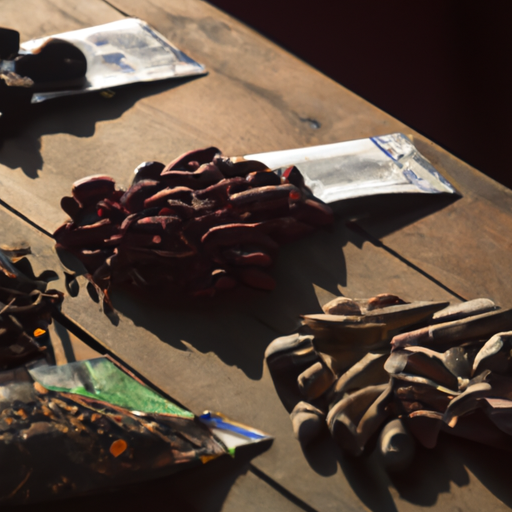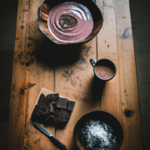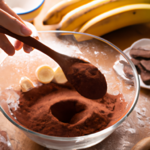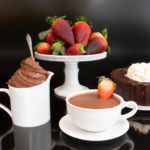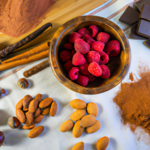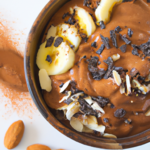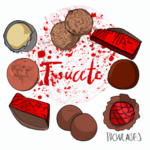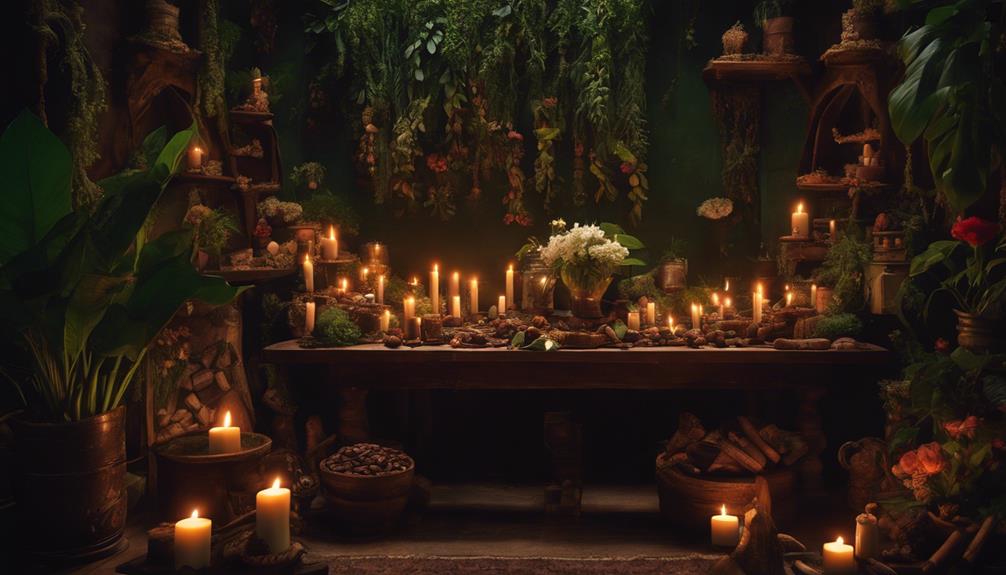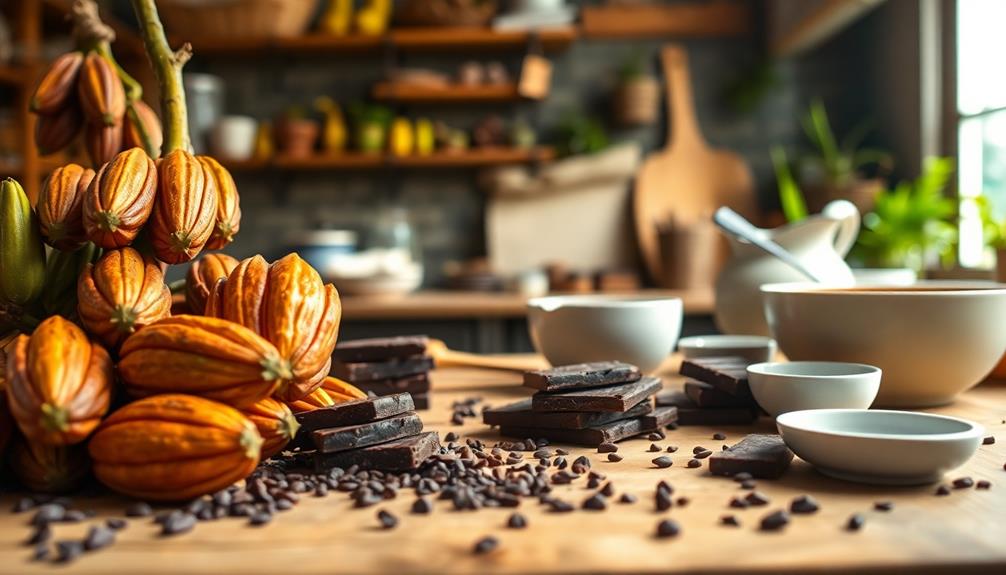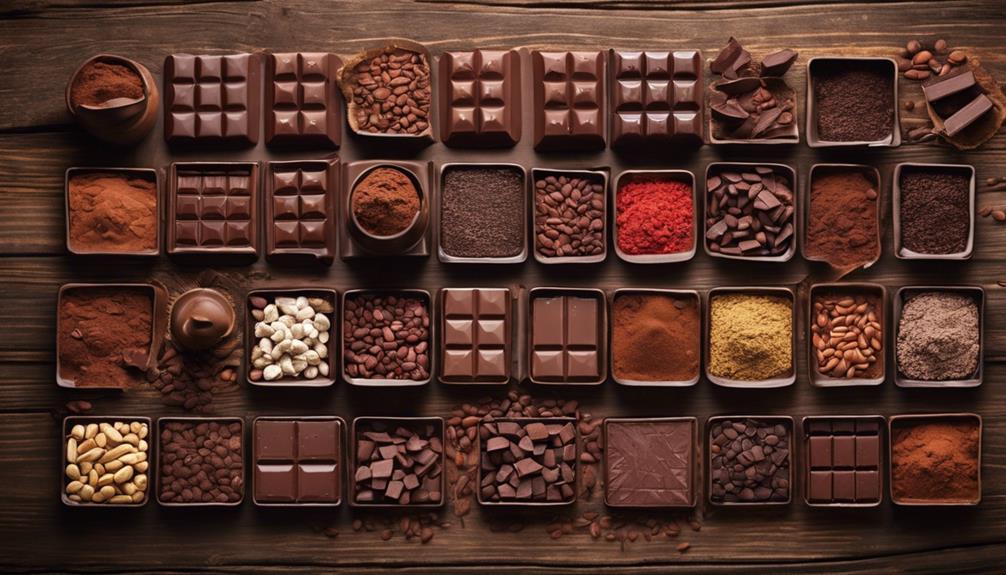Picture yourself enjoying a creamy, decadent chocolate delight that not only fulfills your dessert cravings but also provides essential nutrients for your well-being. This is the enchantment of raw cacao powder.
As a self-proclaimed chocolate lover, I’ve discovered countless ways to incorporate this heavenly ingredient into my daily life. From indulgent desserts and healthy smoothies to homemade hot chocolate and baked goods, the possibilities are endless.
But it doesn’t stop there. Raw cacao powder can elevate your breakfast delights, add a delectable twist to nut butter spreads, and even be used in savory dishes. And let’s not forget about the enticing chocolate snacks and irresistible drinks and cocktails you can create.
In this article, I’ll guide you through the wonderful world of raw cacao powder and show you how to use it in ways you never imagined. So, get ready to embark on a tantalizing journey that will awaken your taste buds and leave you craving more.
Key Takeaways
- Raw cacao powder can be used in a variety of dishes, including baking, breakfast recipes, savory dishes, and beverages.
- Recipes using raw cacao powder are not only delicious but also nutritious, providing a deep chocolate flavor and potential health benefits.
- Nut butter spreads made with almond, cashew, or peanut butter are a creamy and nutritious option, rich in healthy fats, protein, and fiber.
- Cacao-infused treats like chocolate fondue and chocolate-covered fruit offer a heavenly and convenient snacking experience.
Indulgent Desserts
You can satisfy your sweet tooth and transport yourself to a world of chocolatey bliss by adding a sprinkle of raw cacao powder onto your favorite indulgent dessert recipes. Whether you’re craving brownies, cookies, or cakes, this versatile ingredient adds a rich and decadent flavor that will take your creations to the next level.
Get creative and experiment with different ways to incorporate raw cacao powder into your indulgent desserts. Try mixing it into the batter for a double chocolate delight or dusting it on top for an extra touch of elegance. The possibilities are endless when it comes to creating these creative chocolate treats.
Now, let’s move on to the next section about healthy smoothies, where we can explore how raw cacao powder can be used to add a nutritious twist to your beverages.
Healthy Smoothies
Blend together this nutrient-packed superfood with your favorite fruits and veggies to create a deliciously invigorating elixir that will send your taste buds on a tantalizing journey.
Healthy smoothie recipes are a fantastic way to incorporate raw cacao powder into your diet and enjoy its numerous benefits. Not only does raw cacao powder add a rich and chocolatey flavor to your smoothies, but it also brings a host of health benefits.
Packed with antioxidants, raw cacao powder can help reduce inflammation, improve heart health, and boost your mood. Additionally, it is a great source of magnesium, iron, and fiber.
To maximize the benefits of raw cacao powder in your smoothie, try adding it with a handful of spinach and a dash of almond milk for a nutrient-dense and energizing start to your day.
Now, let’s move on to the next section and explore how you can use raw cacao powder to make homemade hot chocolate.
Homemade Hot Chocolate
When it comes to homemade hot chocolate, there are three classic variations that are sure to warm your soul.
First, there’s the classic hot chocolate with marshmallows, a comforting and nostalgic choice.
Then, for those who like a little kick, there’s the spiced Mexican hot chocolate, with its blend of cinnamon, chili powder, and cocoa.
And finally, for a refreshing twist, there’s the minty peppermint hot chocolate, perfect for a cozy winter evening.
Whether you prefer a classic, spicy, or minty version, homemade hot chocolate is a delightful treat that will satisfy any chocolate lover.
Classic Hot Chocolate with Marshmallows
To create a cozy treat, simply combine the velvety raw cacao powder with warm milk and top it off with fluffy marshmallows.
Classic hot chocolate is a timeless favorite, and making it at home is easier than you might think. Start by heating up your choice of milk, whether it’s dairy or a vegan alternative like almond or coconut milk. Once it’s warm, whisk in a generous amount of raw cacao powder, about 2 tablespoons per cup of milk. This rich and decadent powder adds a deep chocolate flavor that is sure to satisfy your cravings.
Top it off with a handful of marshmallows and let them melt into the hot chocolate, creating a creamy and dreamy treat.
Now, let’s move on to the next section and explore the delicious world of spiced Mexican hot chocolate.
Spiced Mexican Hot Chocolate
Spiced Mexican hot chocolate is a delightful twist on the classic treat, adding a hint of warmth and spice to the rich chocolate flavor. This spiced hot cocoa combines the smoothness of chocolate with the comforting aroma of cinnamon, creating a truly indulgent experience.
To make this delicious beverage, start by heating milk in a saucepan over medium heat. Add raw cacao powder, sugar, ground cinnamon, and a pinch of chili powder for that extra kick. Whisk everything together until the ingredients are well combined and the mixture is hot.
Pour the spiced Mexican hot chocolate into your favorite mug and garnish with a sprinkle of cinnamon. The result is a velvety smooth cinnamon chocolate drink that will warm you up from the inside out.
Now, let’s move on to the next delightful variation: minty peppermint hot chocolate.
Minty Peppermint Hot Chocolate
Indulge yourself in a comforting and festive treat with our minty peppermint hot chocolate. This delicious concoction combines the rich flavors of homemade hot cocoa with the refreshing taste of peppermint. Here’s why you should give it a try:
-
Warms your soul: The creamy texture and soothing warmth of the peppermint mocha will instantly melt away your stress and worries.
-
Festive flavors: The combination of chocolate and peppermint creates a delightful balance of sweetness and freshness, perfect for the holiday season.
-
Aromatic bliss: The aroma of the minty hot chocolate will fill your kitchen with a delightful fragrance, making the experience even more enjoyable.
-
Easy to make: With just a few simple ingredients, you can whip up this delicious treat in no time.
So, sip on this minty peppermint hot chocolate and get ready to dive into the world of baked goods, where we’ll explore the mouthwatering possibilities of using raw cacao powder.
Baked Goods
When it comes to baked goods, nothing satisfies my chocolate cravings quite like a moist chocolate cake. The rich, velvety texture and intense chocolate flavor make it the ultimate indulgence.
And who can resist a batch of chewy chocolate chip cookies? With their gooey centers and crispy edges, they are the perfect sweet treat.
But if you’re looking for something extra fudgy and decadent, then fudgy chocolate brownie cookies are the way to go. These little bites of heaven are dense, chewy, and packed with intense chocolate flavor.
Whether you’re baking for a special occasion or just want to satisfy your sweet tooth, these three chocolate delights are sure to hit the spot.
Moist Chocolate Cake
To make a moist chocolate cake, you’ll need to mix raw cacao powder with other ingredients. Raw cacao powder is a healthier alternative to regular cocoa powder, as it is less processed and retains more of its natural nutrients. It adds a rich, deep chocolate flavor to your cake.
Start by preheating your oven and greasing your cake pans. In a large bowl, combine the raw cacao powder, flour, sugar, baking powder, and salt.
In a separate bowl, whisk together the eggs, milk, oil, and vanilla extract. Gradually add the wet ingredients to the dry ingredients and mix until just combined. Pour the batter into the prepared pans and bake until a toothpick inserted into the center comes out clean.
Once cooled, you can frost your cake with a decadent frosting or serve it warm for a gooey chocolate lava cake experience.
Now, let’s move on to the next section about chewy chocolate chip cookies.
Chewy Chocolate Chip Cookies
Sink your teeth into a warm batch of chewy chocolate chip cookies, oozing with melted chocolate and boasting a delightful balance of crispy edges and soft, gooey centers. These cookies are a true chocolate lover’s dream, and here’s how you can make them at home:
-
Start by preheating your oven to 350°F (175°C) and lining a baking sheet with parchment paper.
-
In a mixing bowl, cream together softened butter, granulated sugar, and brown sugar until light and fluffy.
-
Add in an egg and vanilla extract, mixing until well combined.
-
Gradually add in a mixture of all-purpose flour, baking soda, and salt, until a thick dough forms.
-
Gently fold in an abundance of chocolate chips, and drop rounded spoonfuls onto the prepared baking sheet.
-
Bake for 10-12 minutes, or until the edges are golden brown and the centers are slightly undercooked.
-
Let the cookies cool on the baking sheet for a few minutes before transferring them to a wire rack to cool completely.
Now, let’s move on to the next indulgent treat: fudgy chocolate brownie cookies.
Fudgy Chocolate Brownie Cookies
Indulge yourself in the decadent delight of fudgy chocolate brownie cookies. These cookies are a wonderful variation of traditional fudgy brownies, combining the best of both worlds. Made with raw cacao powder, they deliver a deep, intense chocolate flavor that is truly irresistible. The texture is perfectly chewy and dense, just like a brownie, but in cookie form.
Plus, these cookies are gluten-free, making them a great option for those with dietary restrictions. Whether you’re a chocolate lover or simply looking for a delicious gluten-free treat, these fudgy chocolate brownie cookies are sure to satisfy your sweet tooth.
Now, let’s move on to some breakfast delights that will start your day off right.
Breakfast Delights
Starting your day with a warm, gooey chocolate chip pancake made with raw cacao powder is like waking up to a mouthwatering cocoa dream.
Cacao smoothie bowls are a nutritious and delicious way to incorporate raw cacao powder into your breakfast routine. Simply blend frozen bananas, almond milk, and a spoonful of raw cacao powder for a creamy and indulgent morning treat.
Cacao granola bars are the perfect grab-and-go option for those busy mornings. Mix together oats, nuts, seeds, and raw cacao powder, then bind it all together with honey or nut butter for a satisfying and energizing breakfast on the run.
Raw cacao powder can also be added to your morning coffee or hot chocolate for an extra boost of rich chocolate flavor.
Sprinkle raw cacao powder on top of your favorite breakfast smoothie or yogurt bowl for a decadent and antioxidant-rich start to your day.
Now, let’s move on to the delicious world of nut butter spreads.
Nut Butter Spreads
Experience the creamy and irresistible delight of nut butter spreads. Spread a world of flavor on your morning toast. Nut butter spreads are not only delicious but also packed with nutrients that can benefit your overall health.
Whether you prefer almond, cashew, or peanut butter, there are endless possibilities for creating mouthwatering nut butter recipes. These spreads are rich in healthy fats, protein, and fiber, making them a great addition to your breakfast routine.
Not only do they provide a satisfying and filling start to your day, but they also offer numerous health benefits. These include improving heart health, aiding in weight management, and reducing the risk of chronic diseases.
So go ahead, indulge in the goodness of nut butter spreads and elevate your breakfast experience.
Now, let’s move on to the next section and explore some delectable chocolate snacks.
Chocolate Snacks
Satisfy your chocolate cravings with an array of delectable snacks that will transport your taste buds to a world of pure cocoa bliss. Indulge in the velvety goodness of chocolate fondue, where you can dip an assortment of fruits like strawberries, bananas, and pineapple into a luscious pool of melted chocolate. The combination of the sweet, juicy fruit and the rich, smooth chocolate creates a heavenly flavor explosion in every bite. If you’re looking for a quick and convenient snack, try chocolate covered fruit. Whether it’s chocolate-dipped strawberries or chocolate-coated blueberries, these bite-sized treats offer a burst of sweetness that is hard to resist. With just one bite, you’ll be transported to chocolate paradise. Now, let’s move on to the next section and explore how to incorporate raw cacao powder into savory dishes.
Savory Dishes
Get ready to tantalize your taste buds with savory dishes that incorporate the rich and indulgent flavors of chocolate. Here are three mouthwatering ideas to elevate your culinary experience:
-
Savory Pasta: Take your favorite pasta dish to the next level by adding a touch of raw cacao powder. Its deep, earthy notes perfectly complement the richness of tomato-based sauces or creamy Alfredo. Trust me, this unexpected twist will leave you craving for more.
-
Roasted Vegetables: Transform ordinary roasted vegetables into a culinary masterpiece by sprinkling them with a dusting of raw cacao powder. The chocolate undertones enhance the natural sweetness of vegetables like sweet potatoes, carrots, and Brussels sprouts, adding a unique depth of flavor.
-
Delicious Marinades: Incorporate raw cacao powder into your marinades for meats or tofu, and let it work its magic. The bitter-sweetness of the cacao infuses the proteins, imparting a subtle yet irresistible complexity.
Now, let’s move on to the next section and explore how to incorporate raw cacao powder into drinks and cocktails.
Drinks and Cocktails
Indulge in the decadent world of chocolate-infused beverages and cocktails, where the rich flavors of cacao dance with your taste buds in a delightful and unexpected way.
When it comes to drinks with cacao, the possibilities are endless. Start your day off right with a velvety smooth cacao smoothie, blending ripe bananas, almond milk, and a sprinkle of raw cacao powder for a healthy and indulgent treat.
For a more adult twist, try a cacao-infused cocktail like a Chocolate Martini or a Cacao Old Fashioned. The bitterness of the cacao pairs perfectly with the sweetness of the alcohol, creating a balanced and sophisticated drink.
Don’t be afraid to experiment with cacao in your drinks and cocktails, as it adds a unique depth and complexity that will impress even the most discerning palate.
Cheers to the world of cacao-infused beverages!
Frequently Asked Questions
Can raw cacao powder be used as a substitute for regular cocoa powder in baking recipes?
Yes, raw cacao powder can be used as a substitute for regular cocoa powder in baking recipes. It offers several benefits such as being less processed, higher in antioxidants, and having a richer taste. The main difference between the two is the processing method.
Is raw cacao powder suitable for individuals with lactose intolerance or dairy allergies?
Oh boy, do I have good news for all you lactose intolerant folks out there! Raw cacao powder is a fantastic alternative for those with dairy allergies or lactose intolerance. It’s a delicious and dairy-free option for satisfying your chocolate cravings.
What is the recommended serving size of raw cacao powder in a healthy smoothie?
The recommended serving size of raw cacao powder in a healthy smoothie is usually around 1-2 tablespoons. Incorporating this amount can provide numerous benefits, such as antioxidants, minerals, and a natural energy boost.
How can raw cacao powder be incorporated into savory dishes?
To incorporate raw cacao powder into savory dishes, you can use it in pasta sauces to add depth and richness. It can also be incorporated into marinades for savory meats, adding a unique and delicious flavor.
Can raw cacao powder be used to make non-alcoholic drinks and mocktails?
Yes, raw cacao powder can be used to make delicious non-alcoholic drinks and mocktails. There are countless creative mocktail ideas and non-alcoholic cacao recipes that incorporate this rich and flavorful ingredient.
Are There Different Ways to Use Raw Cacao Powder in Recipes?
Yes, there are various ways to incorporate raw cacao powder into recipes. It can be used in smoothies, oatmeal, baked goods, or as a topping for yogurt or fruit. The rich and intense flavor of raw cacao powder adds depth to any raw cacao powder recipe.
Conclusion
In conclusion, incorporating raw cacao powder into your daily routine can elevate your culinary experience to new heights. From indulgent desserts to healthy smoothies and homemade hot chocolate, the possibilities are endless.
Not only does it add a rich and decadent flavor to your dishes, but it also packs a powerful punch of antioxidants and nutrients.
So why not explore the world of cacao and unlock its true potential? Let your taste buds embark on a journey of pure bliss and let the magic of cacao transform your creations into culinary masterpieces.
Embrace the irresistible allure of cacao and let it awaken your senses to a world of gastronomic delight.


